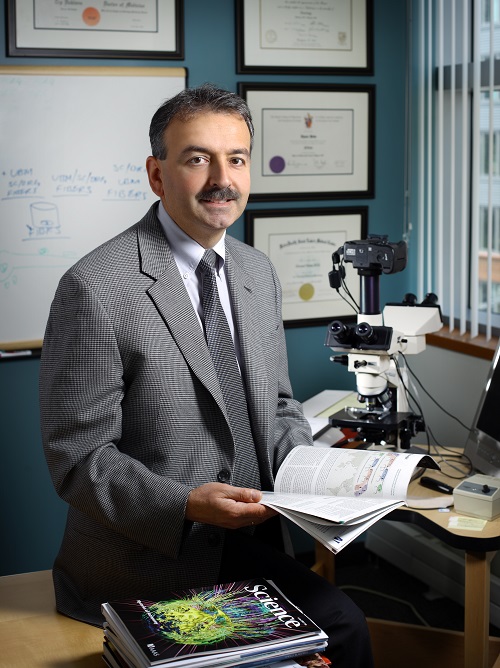A Conversation with Ahmet Hoke
In every issue of The Bridge, we aim to introduce a member of our diaspora. These individuals touched the lives of many by their research, teaching or service activities. Our guest on this issue of The Bridge is Ahmet Hoke, Professor of Neurology, and the Director of Neuromuscular Division at Johns Hopkins University.
The Bridge: Could you please give us a brief summary of your background?
Ahmet Hoke: I was born in Diyarbakir and raised in Mersin, Turkey. I attended Tarsus American High School and entered Hacettepe University Faculty of Medicine in 1982 as a member of the first class of the English curriculum track. Two weeks after graduating from Hacettepe with my MD degree, I came to the USA to study neuroscience. Initially I was at the University of Illinois, Champaign-Urbana, but at the end of my first year, I transferred to Case Western Reserve University’s newly formed Neuroscience Department. I completed my PhD studies in 1994 in developmental neuroscience and then my neurology residency at Johns Hopkins University 1994-1997. Following a 2 year neuromuscular fellowship at University of Calgary, Canada, I was recruited back to Johns Hopkins University as Assistant Professor in 1999. I became an Associate Professor in 2005 and same year I was appointed as the Director of the Neuromuscular Fellowship. In 2009 I obtained my full Professorship. In addition to my research I enjoy editorial activities. I was an associate editor for Experimental Neurology 2006-2012 and in January of 2013 I became the Editor-in-Chief of Experimental Neurology. I serve on several other editorial boards and I am an Associate Editor for Annals of Clinical and Translational Neurology.
T.B. : Could you also summarize your studies/research?
A. H. : My research interest includes studies on biology of peripheral axons and Schwann cells and disorders affecting the peripheral nervous system. We use in vitro and in vivo models of peripheral neuropathies (HIV-associated sensory neuropathy, diabetic neuropathy and toxic neuropathies) to study the mechanism of axonal damage and identify therapeutic targets for drug development. In addition, I have an additional research interest focusing on mechanisms of axonal degeneration and regeneration using in vitro and in vivo models. We research novel chemicals to treat peripheral neuropathies and utilize engineered stem cells as therapeutic gene delivery tools to promote axonal regeneration in chronically denervated nerves as seen in nerve injuries and many degenerating disorders of the peripheral nervous system such as amyotrophic lateral sclerosis and inherited neuropathies.
T.B. : Where do you see studies of your area of specialty in Turkey? What are your suggestions to improve the research in Turkey in this area?
A. H. : Research on neuromuscular diseases is strong in the clinical arena with good phenotyping of rare inherited neuromuscular disorders. Unfortunately, there are very few groups doing good basic science research in neuromuscular disorders and nerve regeneration. This is partly due to lack of training and exposure to good lab practices and partly due to lack of funding.
T.B. : Would you please tell us about the current status of collaboration between the US and Turkish research institutions in your field? What can be done to increase the collaboration and strengthen the bridge between Turkey and the US? And how can TASSA, in your opinion, contribute to it?
A. H. : Unfortunately this is an area that I don’t have a clear answer for. There are few areas of collaboration in neuromuscular diseases, mainly in ALS (Amyotrophic Lateral Sclerosis) and inherited muscle diseases (muscular dystrophies). I think focused scientific meetings between USA and Turkish scientists in this area can enhance collaborations. Perhaps TASSA can be a vessel for such meetings.
T.B. : You have been mentoring many international scientists and scholars and also graduate students throughout your career. What would you advise young scientist for a successful scientific career?
A. H. : I think the most important character trait for a successful scientist is “curiosity”. Techniques can be learned and collaborations can be established. One can learn to write better grant proposals and papers but I’m not sure if scientific curiosity can be learned. I think it inherently is present in every scientist and needs to be nurtured. Things that helped me over my career include frequent scientific discussions with my colleagues and paying attention to detail. A good scientist has to be a bit obsessive about his research. One can, and often, makes mistakes but those who succeed are the ones who pay attention to detail so they can learn from their mistakes and are good at troubleshooting.
T.B. : Could you please tell us about your life outside of your work? Do you have hobbies? What are your favorite activities? If you recommend a book, what would that be and why?
A. H. : I like reading, photography, travel and nature.
Gabriel Garcia Marquez, Italo Calvino, James Joyce and Orhan Pamuk are among my favorite writers. If I had to suggest one book, that would be “A Portrait of the Artist as a Young Man by Joyce.”
